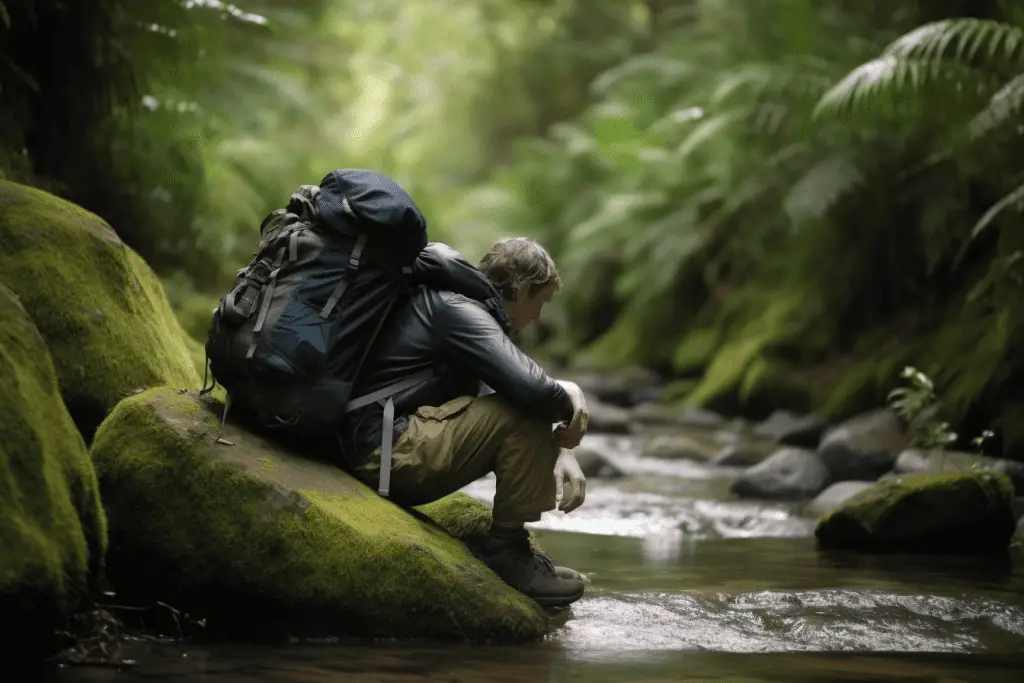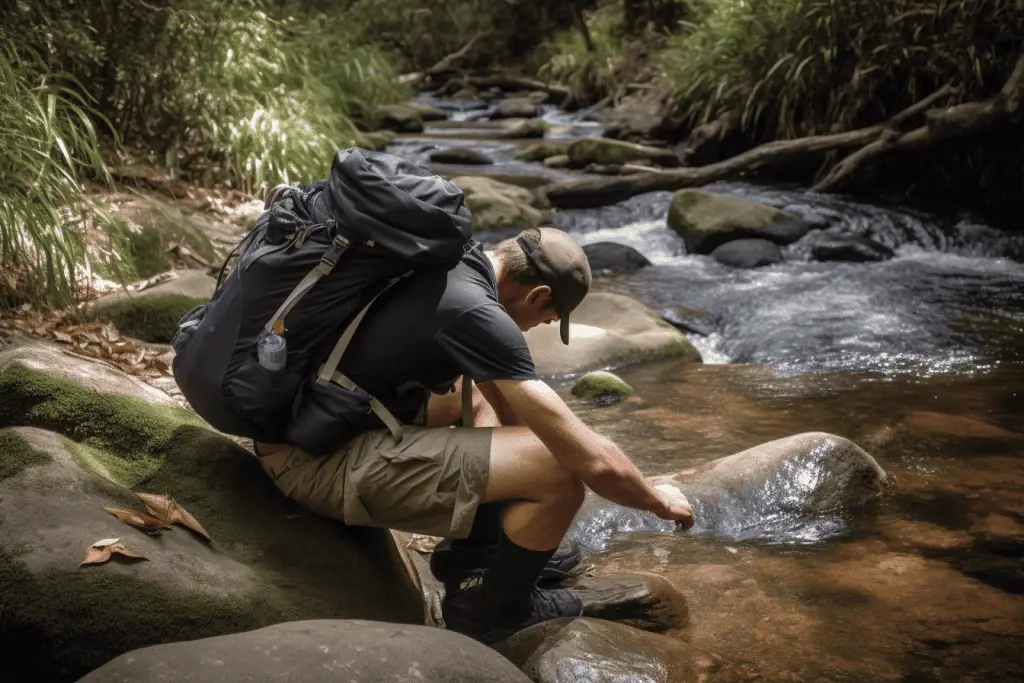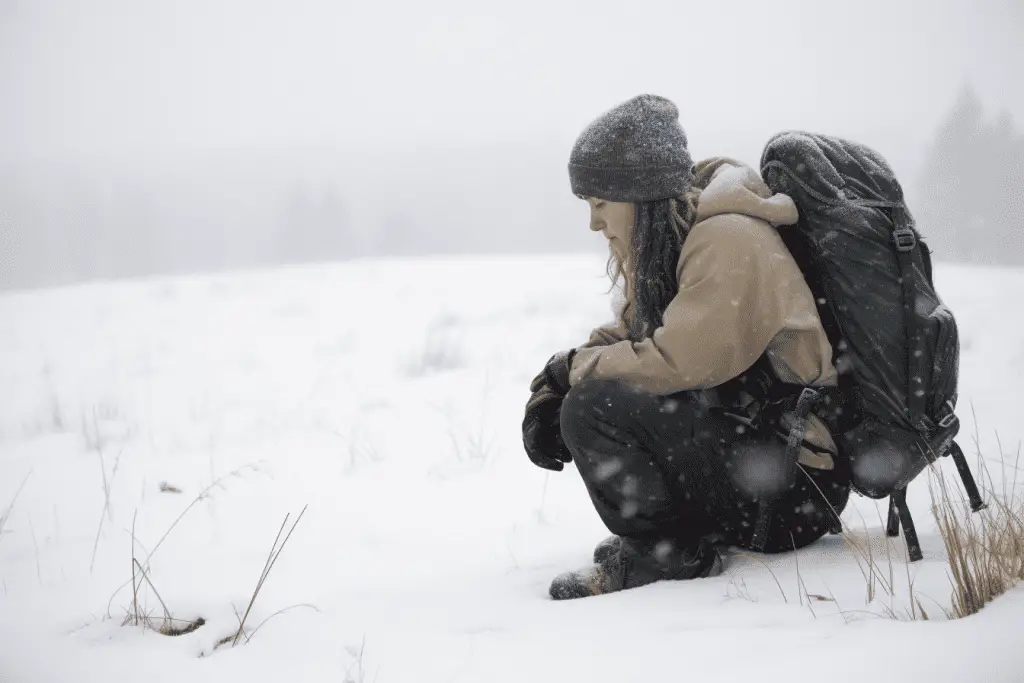Backpackers hike through some of the most beautiful and pristine parts of nature. The lakes and rivers often look pure and clean enough to drink from but can you drink water from a stream while out backpacking?
It is generally not recommended to drink water directly from a stream, as it may contain harmful bacteria, parasites, or pollutants. It is best to filter or purify the water before drinking it, or to bring your own clean water supply.

Risks and Dangers: Why You Shouldn’t Drink Water From a Stream
Streams are nature’s artwork; they ripple and shine, tempting us with their apparent purity. It’s easy to think this clear, cool water is safe to drink – but often, it’s not as pure as it seems. So, why exactly shouldn’t we just dip our water bottles into these seemingly pristine streams?
The primary concern is invisible to the naked eye: microscopic pathogens. These tiny troublemakers include bacteria, parasites, and viruses that can cause illnesses such as Giardia, E. coli, and Cryptosporidium. These names may sound like something out of a sci-fi movie, but they’re very real, and an encounter with them can quickly turn a fantastic backpacking trip into a nightmare. Symptoms of these illnesses range from mild discomfort to severe dehydration, something you definitely want to avoid when you’re miles from civilization.

Streams can also be contaminated with chemicals from both natural and human sources. Agricultural runoff, industrial waste, and even naturally occurring substances like arsenic can leach into a stream, making the water unsafe to drink. While these contaminants are less common than pathogens in many areas, they still pose a significant risk, particularly in regions with intensive farming or mining activities.
In short, while that sparkling stream water might look tempting, it’s always better to be safe than sorry. A sip of water isn’t worth risking your health or ruining your backpacking adventure.
Techniques to Purify Stream Water: The Lowdown on Boiling, Filters, Chemical Treatments, and UV Lights
Venturing into the great outdoors doesn’t mean you have to go thirsty or risk falling ill from contaminated water. Luckily, there are several tried-and-tested methods to make stream water safe for drinking: boiling, filtering, and chemical treatment. Each has its pros and cons, so let’s break it down.
Boiling Water To Make It Safe To Drink
First up, boiling. This is the granddaddy of all water purification methods, known for its simplicity and effectiveness. All you need is a heat source and a container that can withstand high temperatures. Bring the water to a rolling boil for at least one minute, and you’ve got yourself potable water. While it’s highly effective against pathogens, boiling doesn’t remove chemical contaminants and can be time and fuel-consuming. So, does boiling water make it safe to drink?
Boiling water is an effective way to kill most types of disease-causing bacteria and viruses that may be present in the water. However, boiling water will not remove any chemical contaminants that may be present, so it is important to know the source of the water before drinking it.
Backpacking Water Filters
Next, let’s talk about filters. Backpacking water filters are a backpacker’s best buddy, compact enough to fit in your pack and specifically designed to remove most pathogens and even some chemicals. But, remember, filters vary in their effectiveness, and not all are capable of removing viruses. Always check the product specifications before you make a purchase.
Chemical Treatments for Water
Lastly, chemical treatments like iodine or chlorine dioxide tablets can kill bacteria, viruses, and protozoa. They’re lightweight and easy to use, but the downside is that they leave a taste in the water that some people find off-putting. Also, these treatments aren’t effective against all types of contaminants, especially some chemicals.
UV Light Devices
Ultraviolet (UV) light devices are a modern, high-tech solution for water purification during your outdoor adventures. These devices use UV light to quickly neutralize harmful bacteria, viruses, and protozoa, making the water safe to drink in around 90 seconds, without leaving a chemical aftertaste. They come in various forms but require batteries or a power source.
UV devices can’t tackle chemical contaminants or cloudy water with particulates, so pairing them with a filter might be necessary in some situations. Despite these limitations, UV devices offer a rapid, taste-free water treatment method, demonstrating the strides we’ve made in finding innovative ways to stay hydrated and safe while enjoying nature.
So What’s the Best Way To Purify Water While Backpacking?
In a nutshell, each method has its place, and the best one for you depends on where you’re backpacking and what resources you have. So equip yourself with knowledge and the right gear, and you’ll have a safe, hydrated adventure!
Is Melted Snow Safe to Drink?
In the midst of a snow-blanketed wilderness, it’s easy to think you’ve got an endless supply of water just waiting to be melted and sipped. But, as with many things in life, it’s not quite that simple. So, is melting a handful of fresh snow a safe way to quench your thirst during winter hikes?
Generally speaking, fresh snow in remote, high-altitude areas is usually safe to consume after melting and boiling. Boiling not only ensures that the water reaches a safe temperature to kill off any potential pathogens, but it also accelerates the melting process. So if you’ve got a stove and fuel, you’re good to go.

However, there are some caveats. First, avoid the snow that isn’t pristine white. Snow can absorb pollutants from the air, and yellow, pink, or green snow can indicate the presence of algae or animal waste. Even if the contaminants aren’t harmful per se, they can make the water taste pretty awful.
Another consideration is that melting snow requires a significant amount of fuel. If you’re on a multi-day hike in freezing conditions, you might need that fuel for cooking, so factor that into your plans. Also, remember that snow is much less dense than water, so it takes a lot of snow to provide a small amount of water.
So, while melted snow can be a hydration source in a pinch, it’s not always the most efficient or tastiest. Always make sure to pack enough water and have other water purification methods at hand. It’s better to be over-prepared than risk dehydration in the great outdoors.
Hydrate Wisely: Putting the Stream Water Knowledge into Action
Backpacking offers the unique chance to immerse yourself in nature, with every trek revealing new landscapes and wildlife, challenging terrains, and unforgettable experiences. But all this comes with the responsibility of looking after your health and the environment. When it comes to staying hydrated in the great outdoors, knowledge, and preparation are your best friends.
Remember, while stream water might look crystal clear and inviting, it can harbor invisible threats like pathogens and chemicals. Purification techniques like boiling, filtering, and chemical treatments are your first line of defense, with UV light devices providing a high-tech alternative. And even in the midst of a winter wonderland, don’t be too quick to quench your thirst with melted snow without taking the necessary precautions.
All in all, the importance of clean water can’t be overstated when you’re out on the trail. So, equip yourself with the right tools, a touch of know-how, and a big dose of respect for nature, and you’re all set for a safe, hydrated, and happy backpacking adventure.
